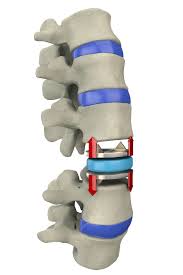 Attempts to maintain disc height and spine curvature at normal levels and provide enough mobility to prevent adjacent segment degeneration.
Attempts to maintain disc height and spine curvature at normal levels and provide enough mobility to prevent adjacent segment degeneration.
Intervertebral disc arthroplasty
Artificial disc replacement (ADR), or total disc replacement (TDR), is a type of arthroplasty.
A surgical procedure in which degenerated intervertebral discs in the spinal column are replaced with artificial disc implants in the lumbar or cervical spine.
Intervertebral disc arthroplasty is used to treat chronic, severe low back pain and cervical pain resulting from degenerative disc disease.
Disc replacement is also an alternative intervention for symptomatic disc herniation with associated radicular pain.
Total disc replacement has been developed as an alternative to spinal fusion, with the goal of pain reduction or elimination, while still allowing motion throughout the spine.
Faster recoveries have also been widely reported.
It is possible that the procedure prevents premature breakdown in adjacent levels of the spine, a potential risk in fusion surgeries, as there is a strong correlation between providing motion in the spine and avoiding adjacent segment degeneration.
Multiple artificial discs have been approved by the FDA for use.
Disc replacements have the highest level of clinical evidence of any spine devices.
All prospective, randomized clinical studies that have been run in the United States have shown lumbar and cervical disc replacements to provide faster recovery, better long-term patient satisfaction, and fewer incidents of adjacent segment degeneration than comparative spinal fusion options.
Disc replacement requires a high level of technical skill for accurate placement and has a significant level of risk if revision surgery is needed.
New studies have identified concerns regarding long-term durability of some devices (M6-C).
